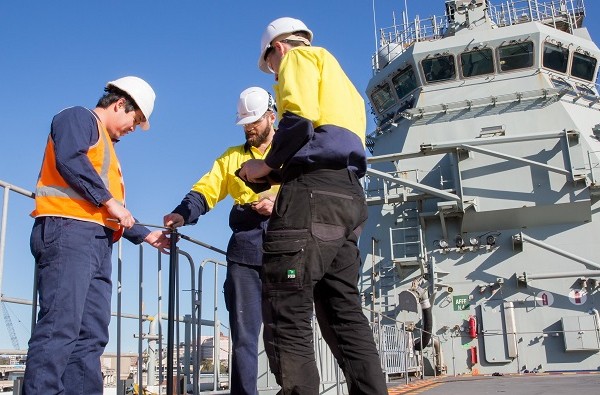New protective coating set to keep ships at sea for longer
A new corrosion-resistant coating that halved the build-up of algae and barnacles on ship hydraulic components is now the subject of on-ship trials aboard HMAS Canberra, one of the Royal Australian Navy landing helicopter dock ships.
Researchers from Swinburne University of Technology are collaborating with experts from MacTaggart Scott Australia, United Surface Technologies and DST Group under a DMTC-managed project to advance the new technology.
The scientists and industry experts came together to tackle the issue of corrosion and biofouling, a significant cost driver for the sustainment of Navy ships and a massive expense for the shipping industry worldwide.

L-R: Andrew Ang, Engineer Matthew Leigh and Technician Jason Phillips install Coated hydraulic actuators on the forward aircraft lift of HMAS Canberra. Credit: POIS Yuri Ramsey, Department of Defence
“Many scientists around the world are looking for new ways to combat biofouling and corrosion,” says Dr Andrew Ang of Swinburne.
“We have developed new materials and used a supersonic combustion flame jet to coat hydraulic machinery parts, and found these new protective coatings reduce biofouling by roughly 50 per cent compared to current standard coatings.”
The team is trialling the treatment (a single layer of carbide-based coating) on parts that require very smooth surfaces. Because these are exposed to harsh operating conditions, they rapidly degrade from biofouling and corrosion.
Dr Richard Piola, from DST Group, says the new surface coatings could make a huge difference to the operational availability of Navy ships, and significantly reduce the cost of maintenance and repairs.
“If the coating can double the length of time a ship can be at sea or available to be deployed—before it needs to be docked and cleaned—it could save costs and also increase operational readiness for the Defence Force.”
The team is testing the protective coating on a prototype system in the field, and have now been invited to conduct the trial on HMAS Canberra.
The Canberra and her sister ship HMAS Adelaide are providing the Australian Defence Force with one of the most capable and sophisticated air-land-sea deployment systems in the world.
The treatment is likely to be too expensive to be used on entire ship hulls, but it could make a big difference for critically important machinery on a ship that helps provide propulsion or heavy lifting capabilities. The team tested the protective coating on more than 100 test samples, immersing them in seawater at three field sites around Australia from 2015 to 2017.
About Andrew Ang

Dr Andrew Ang (Swinburne University of Technology) is one of the lead scientists on the DMTC Project team investigating the performance of new protective coatings on hydraulic shaft components in a marine environment. Dr Ang won the 2018 Fresh Science competition in Victoria for his work and has also been nominated for and/or won a number of DMTC Awards for Excellence including the Early Career Researcher award in 2017 and the Industry Partnership award in 2016 and 2018.
Posted by Harry Baxter on October 10th, 2018 Tagged: collaboration, defence technology, DST, innovation, technology